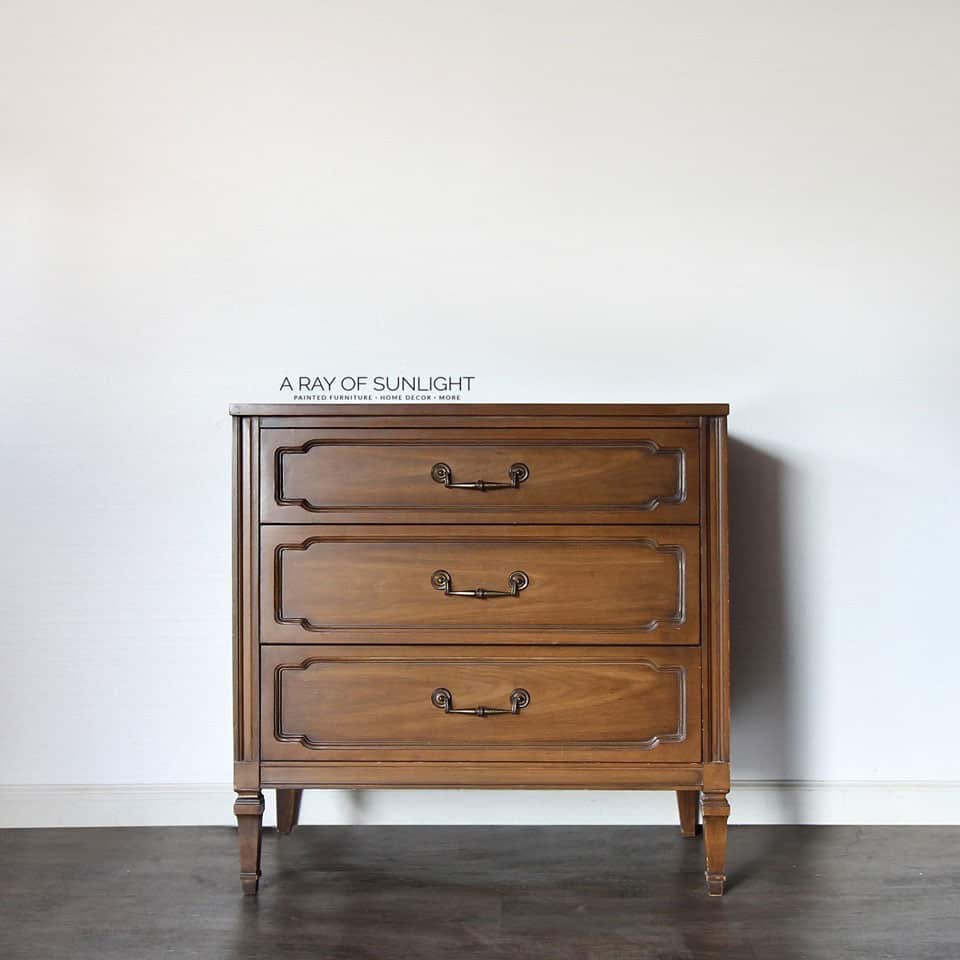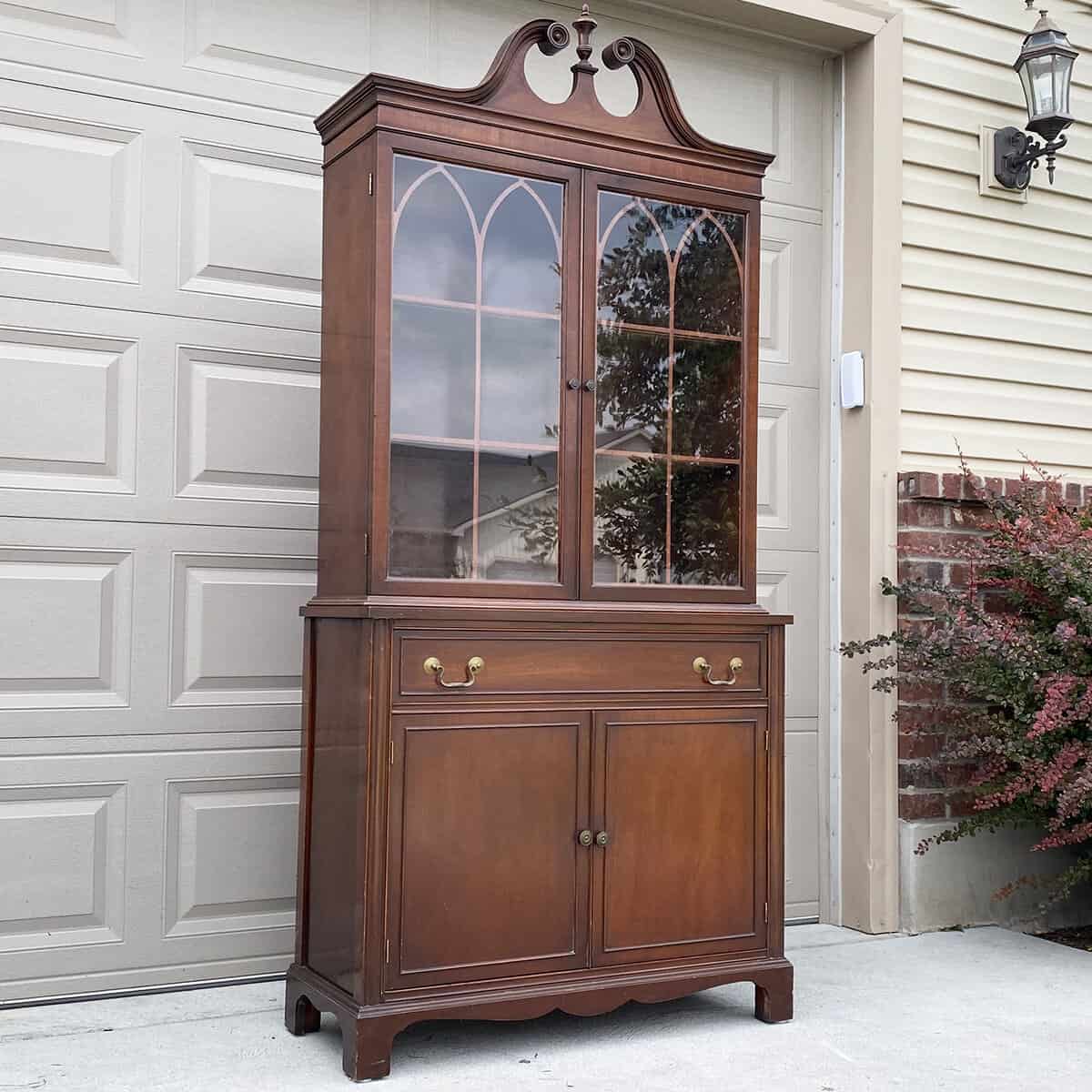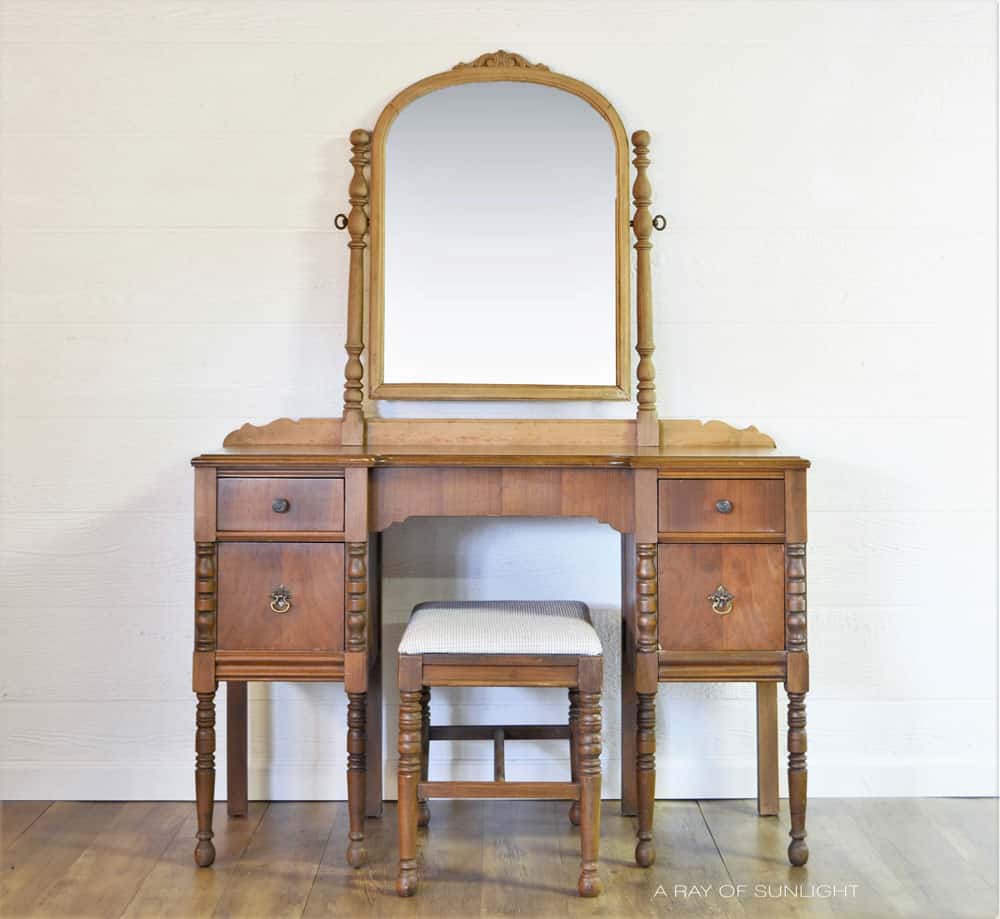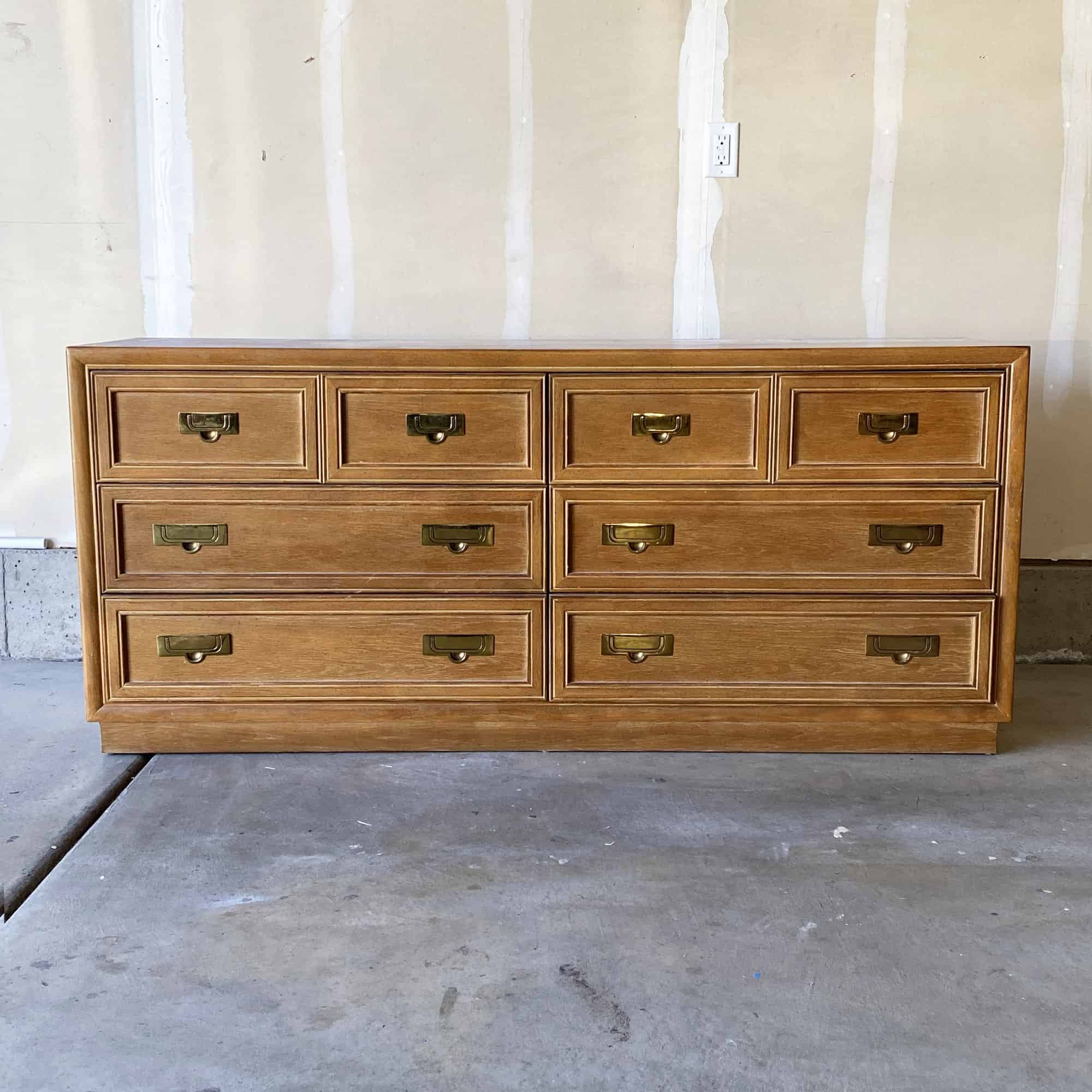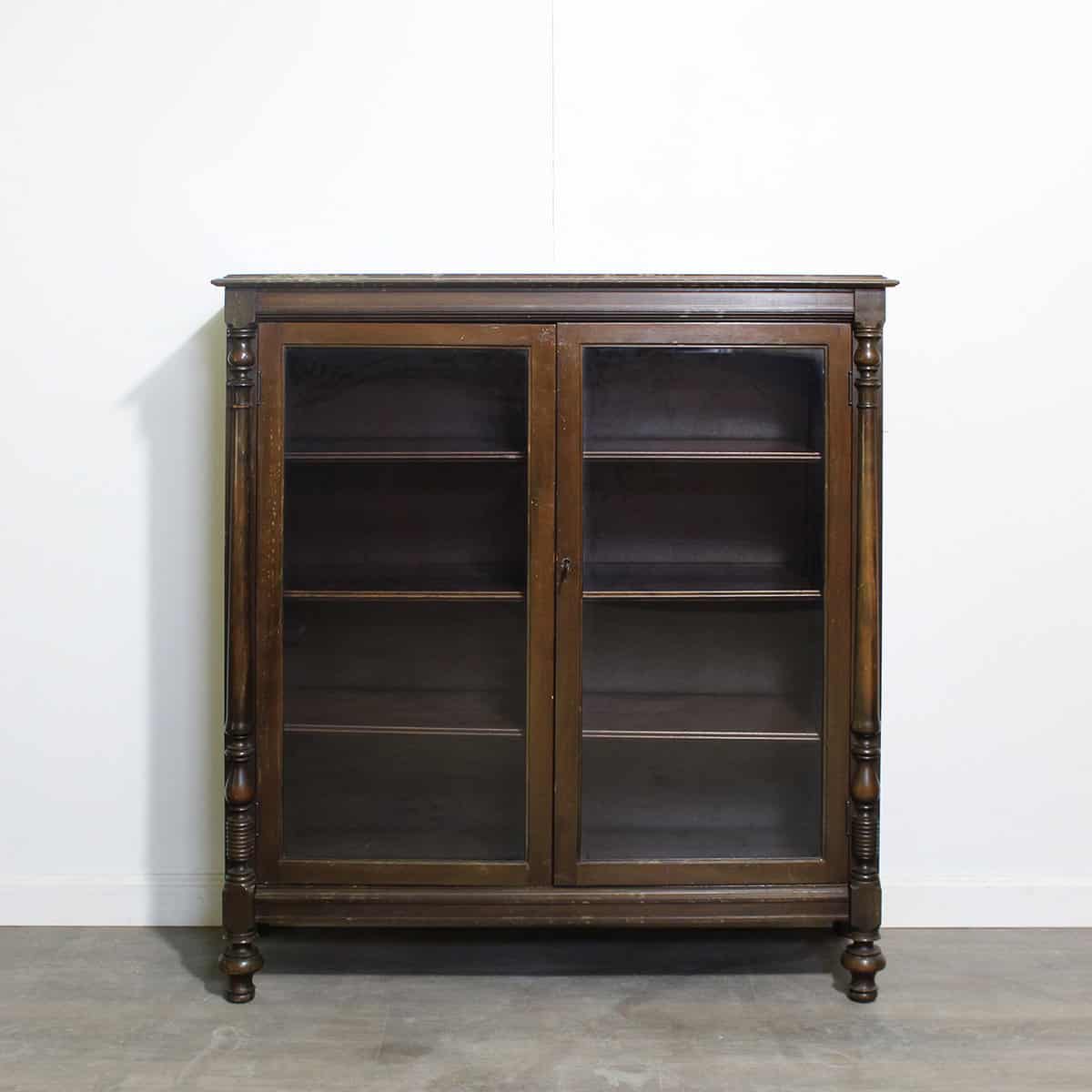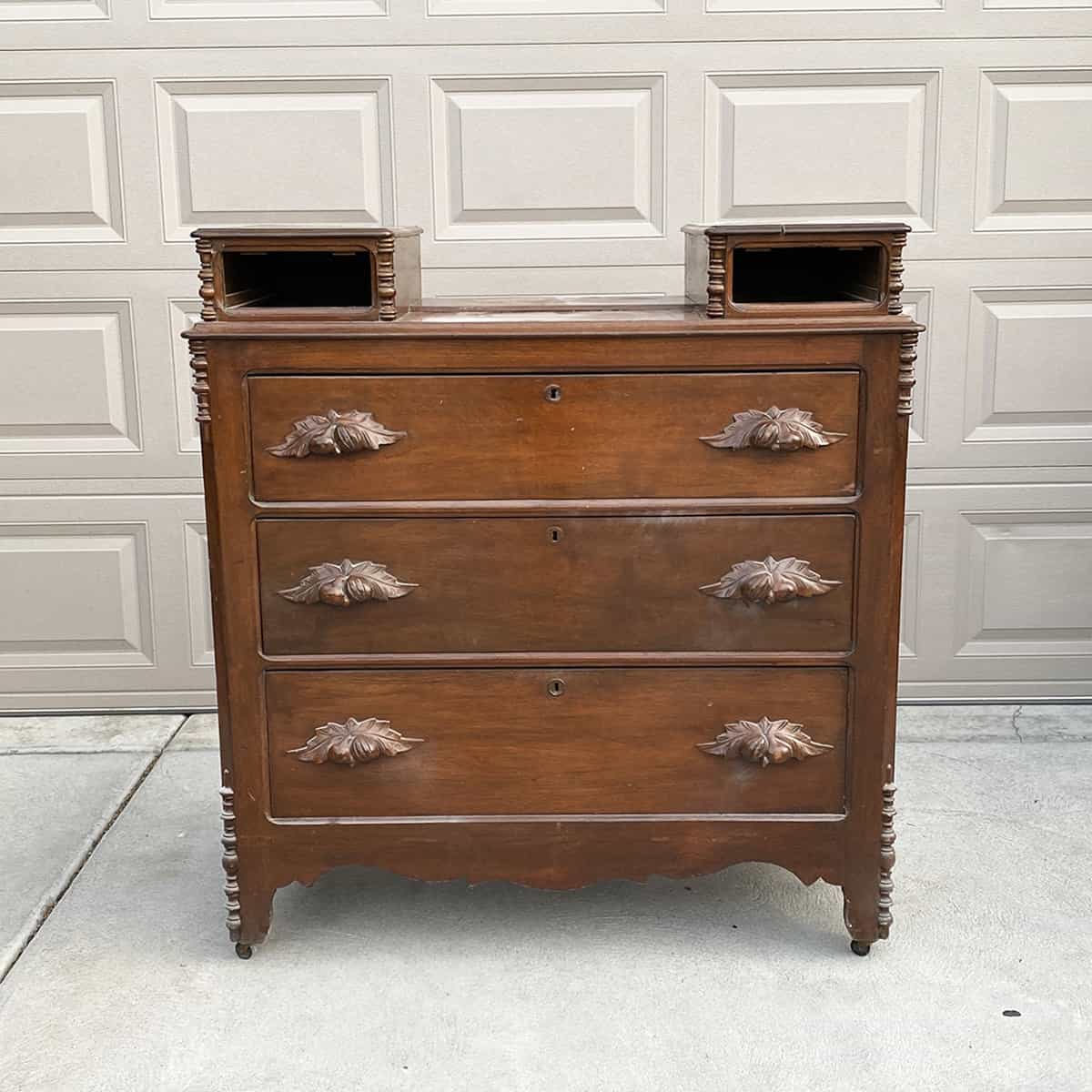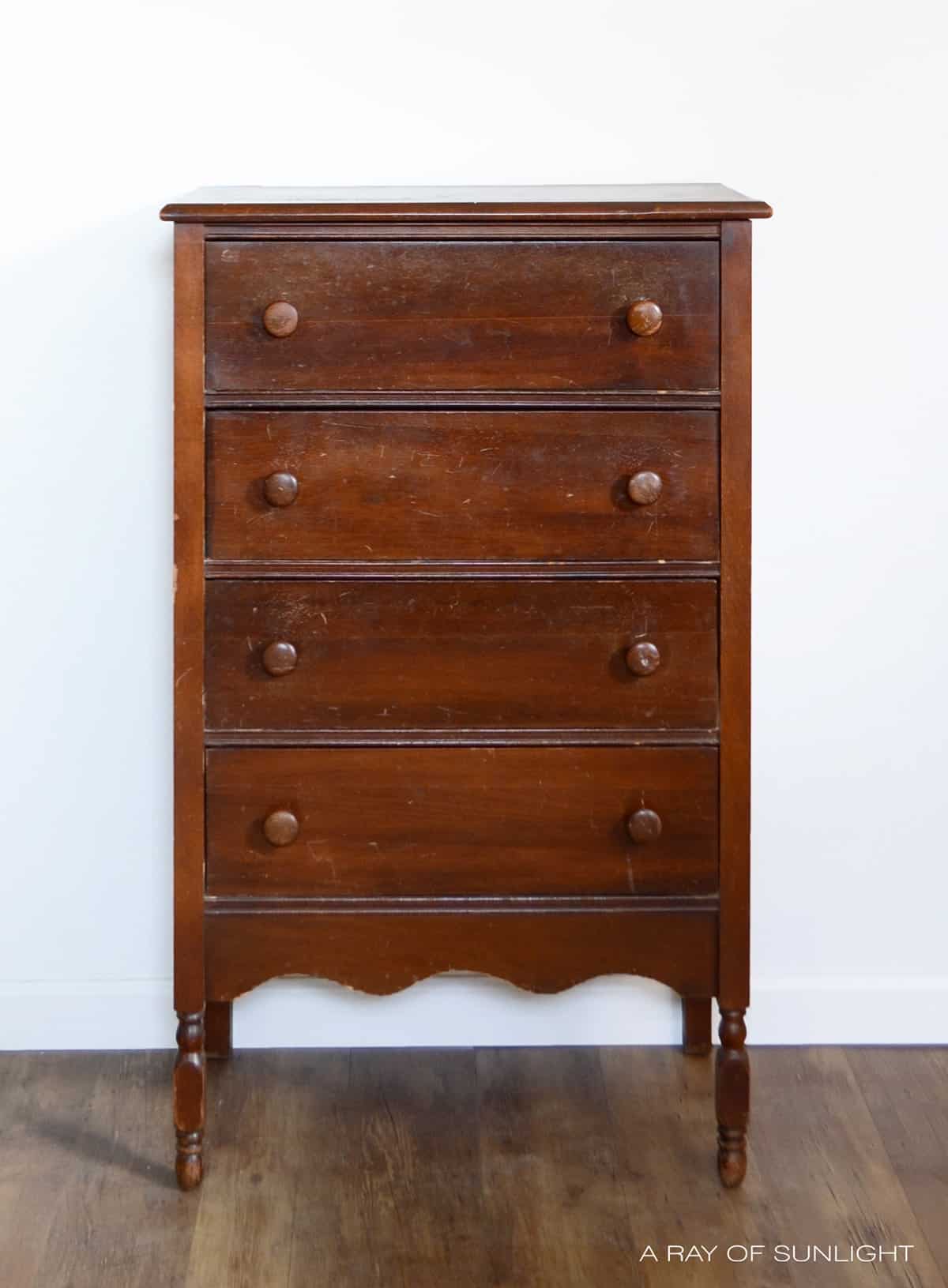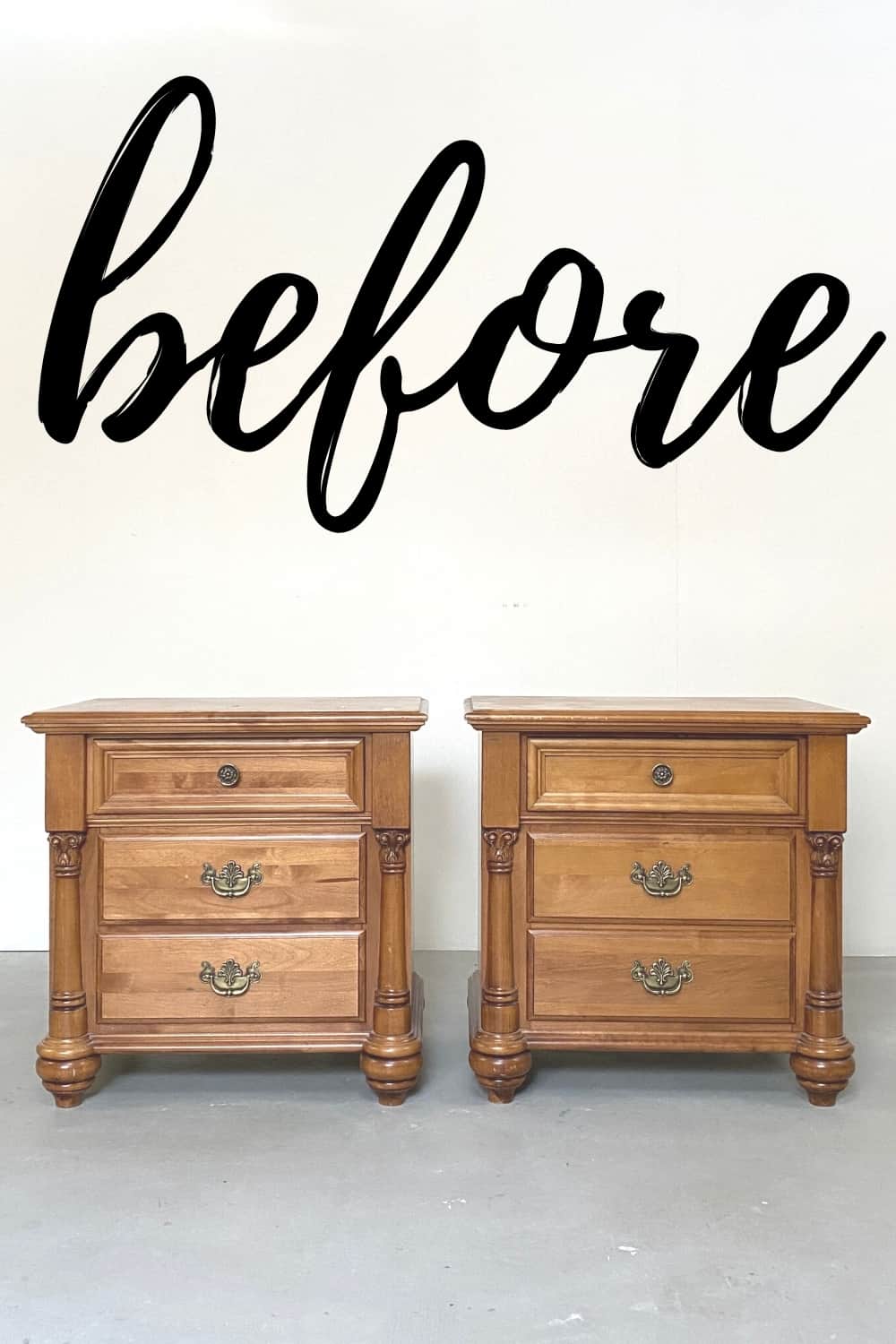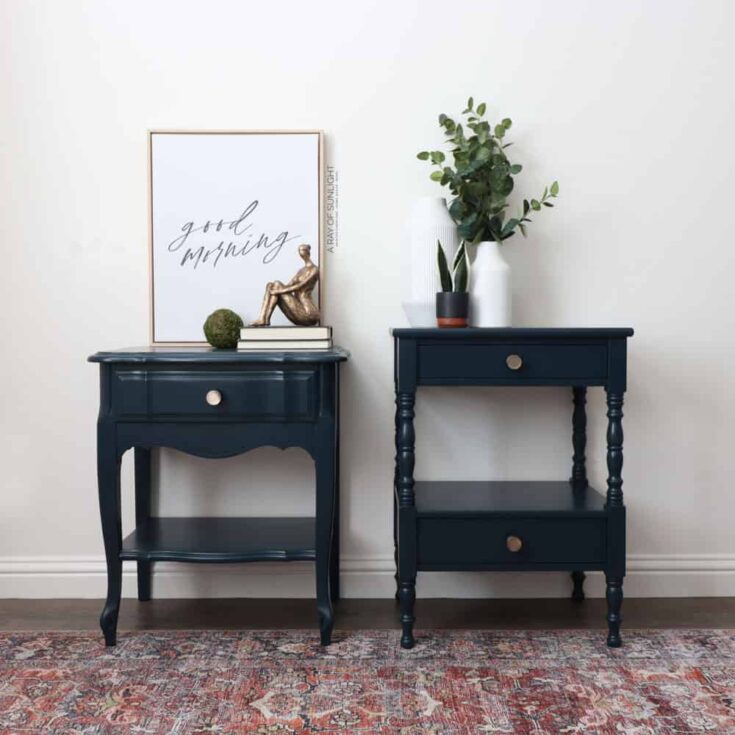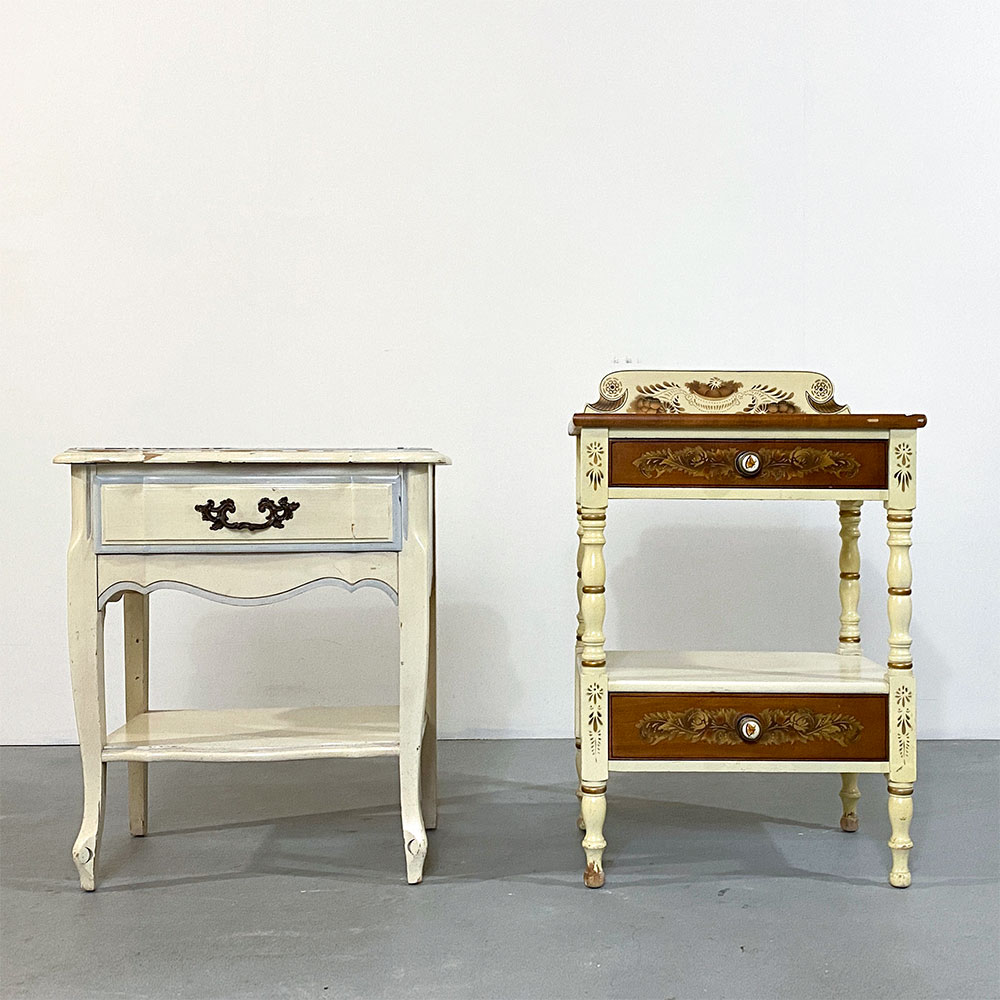DIY Blue Painted Nightstands
Check out how we transformed these mismatching nightstands from the thrift store using chalk paint and a paint sprayer. You will love these DIY blue painted nightstands!
Get more blue painted furniture ideas here!

Alright, these are the nightstands I’m working with. I got them both from a trip to the thrift store. They’re about the same size and height but are completely different styles.
In my experience, single nightstands don’t sell well, so I usually skip over single nightstands. But a pair of nightstands sells well! Especially if they are taller than 24”.
So, my goal is to make them into a mismatched set!
Supplies Used for DIY Blue Painted Nightstands
As an Amazon Associate, I earn from qualifying purchases. I also may earn from other qualifying purchases with other companies or get free product to review and use. All opinions are my own.
- Wagner FLEXiO 3000, which you can get on Amazon or at Home Depot
- KwikWood to fill in hardware holes
- Krud Kutter Cleaner Degreaser
- Old Rag
- 3×4 Electric Ray SurfPrep Sander / Sandpaper (Use code RAY10 to get 10% off)
- Fine Grit Foam Sponge
- Wood Filler
- Shop Vac with Hose and Brush Attachment
- Clear Shellac, which is my favorite primer
- Respirator
- Country Chic Paint in the colors Peacoat and Fireworks
- Measuring Cup
- Paint Filters
- Varathane Water Based Polyurethane – My Favorite Topcoat
- New Knobs
Check out the must have products for painting in our best painting furniture supplies post!
Prep Nightstands for Paint
To get started I did what I always do in preparing furniture for painting.
I removed the hardware. And then I filled in the hardware holes on the French provincial nightstand so I could replace the pull with a knob.
Discover the best product to use for filling holes when replacing furniture hardware here!
The other nightstand just had knobs, so I left the holes alone over there. While I waited for that to dry for an hour, I worked on a few other things.
I removed the backsplash from the colonial style nightstand. It was only attached with 3 screws on the back, so it only took a minute to get it off.
I wasn’t a fan of it…it just made the nightstand look taller and even more different than the French nightstand. Let’s just say that I was glad to see it go.
Cleaning and Scuff Sanding Nightstands Before Painting
Then I cleaned off the dust and grime that was on the nightstands with some Krud Kutter.

They were a bit dirty, so I ended up wiping these nightstands down twice with Krud Kutter and then I used a clean, wet rag to wipe them off one more time.
Learn more on how to clean furniture before painting here.
And then I dove into scuff sanding. I used my handy dandy little SurfPrep sander and a medium grit foam sponge to help me sand all the curves, spindles and details without messing them up.
Learn more about the importance of sanding before painting furniture here.

It’s attached to my shop vac, so most of the dust gets sucked up instead of going into the air.
The French nightstand has a laminate top, so I made sure to give it an extra good sanding to help the paint stick.
Learn what happens when you don’t sand laminate furniture before painting in this post on how to paint laminate furniture without sanding vs sanding.
And then for the rest, I at least sanded enough to just scuff up the old finish to help the paint stick. But I mostly took this time to sand and smooth out everywhere the paint had chipped off or been damaged.
It also gave me the chance to look over each piece really well and I realized that there was a crack on the side of one that needed to be filled in with a little bit of wood filler.
You can choose among the best wood fillers for furniture here! So I filled it in, and let it dry.
By the time it was dry, the KwikWood in the hardware holes was dry, so I sanded both of those areas down flush with the surface of the wood. Learn more about how to use KwikWood here.
And then I used my shop vac with the hose and brush attachment to vacuum the dust that was left behind.
The sander does a really good job at keeping the dust out of the air, and sucking up most of the dust when it’s hooked up to the shop vac.
(Learn more about what you need to get started with the SurfPrep sander here.)
But it still leaves some dust on the surface. So I quickly went over everything with the shop vacuum. And then I wiped it all down with a tack cloth to finish picking up any leftover dust.
If all of the dust isn’t removed, it makes the painted finish more rough and bumpy, so I try to remove all of the dust before painting.
Priming Nightstands Before Painting
Then I moved the nightstands into my paint booth and sprayed 2 coats of shellac on them. Even though shellac isn’t really marketed as a primer, it’s my favorite thing to use as a primer!
Not only does it stop stains from coming through paint, but it helps paint stick to laminate or really slick surfaces! And for these two pieces, I needed both!
I personally always spray the shellac on because it’s so stinking easy to spray it! Learn more about the best primers for painting furniture and how to choose the right one here.
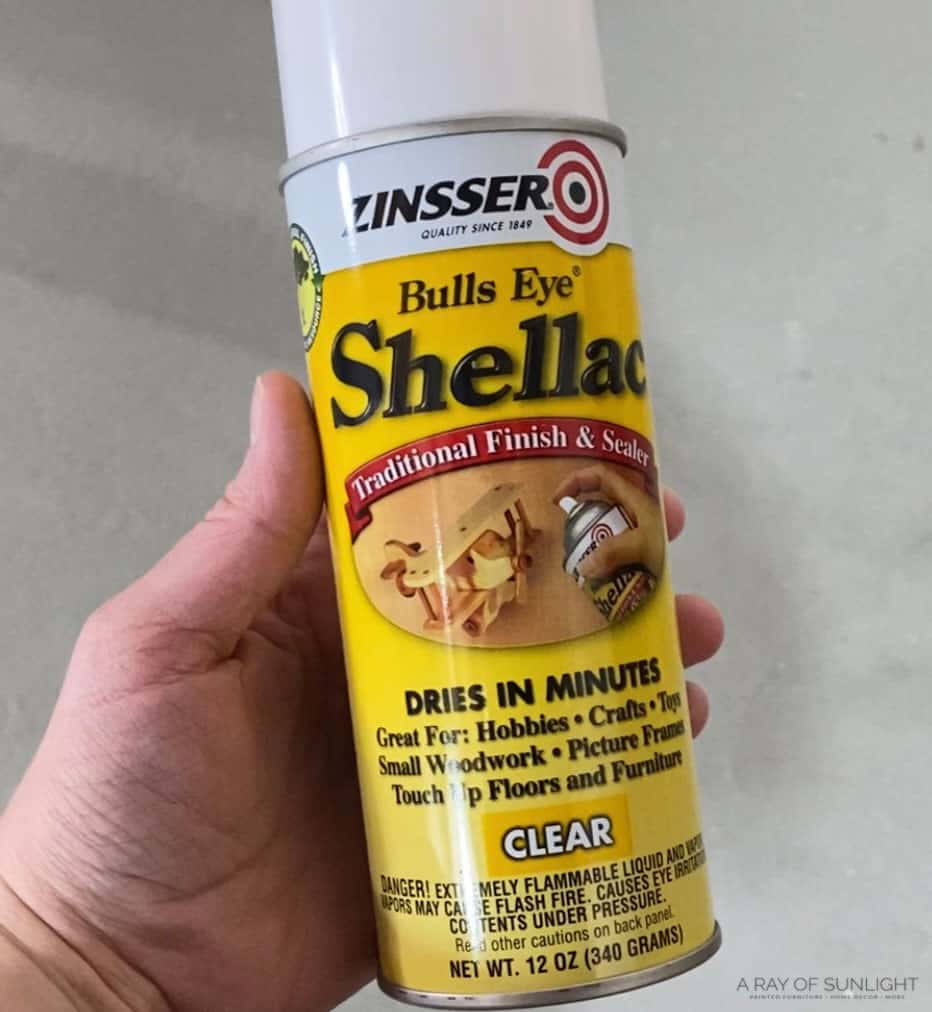
That’s why I love to use a paint sprayer when I paint too! It just saves so much time.
But, you’re not supposed to put shellac products, or products with a flash point of less than 100 degrees in these Wagner sprayers.
And honestly, I don’t want to clean shellac out of my paint sprayer, so I use it in the aerosol spray cans instead.
So I sprayed the 2 coats of clear shellac on each nightstand, letting it dry in between coats. And then I let the shellac dry overnight.
Spray Paint Nightstands with Chalk Paint
The next day I busted into my new toy, this Wagner FLEXiO 3000 that Wagner sent me.
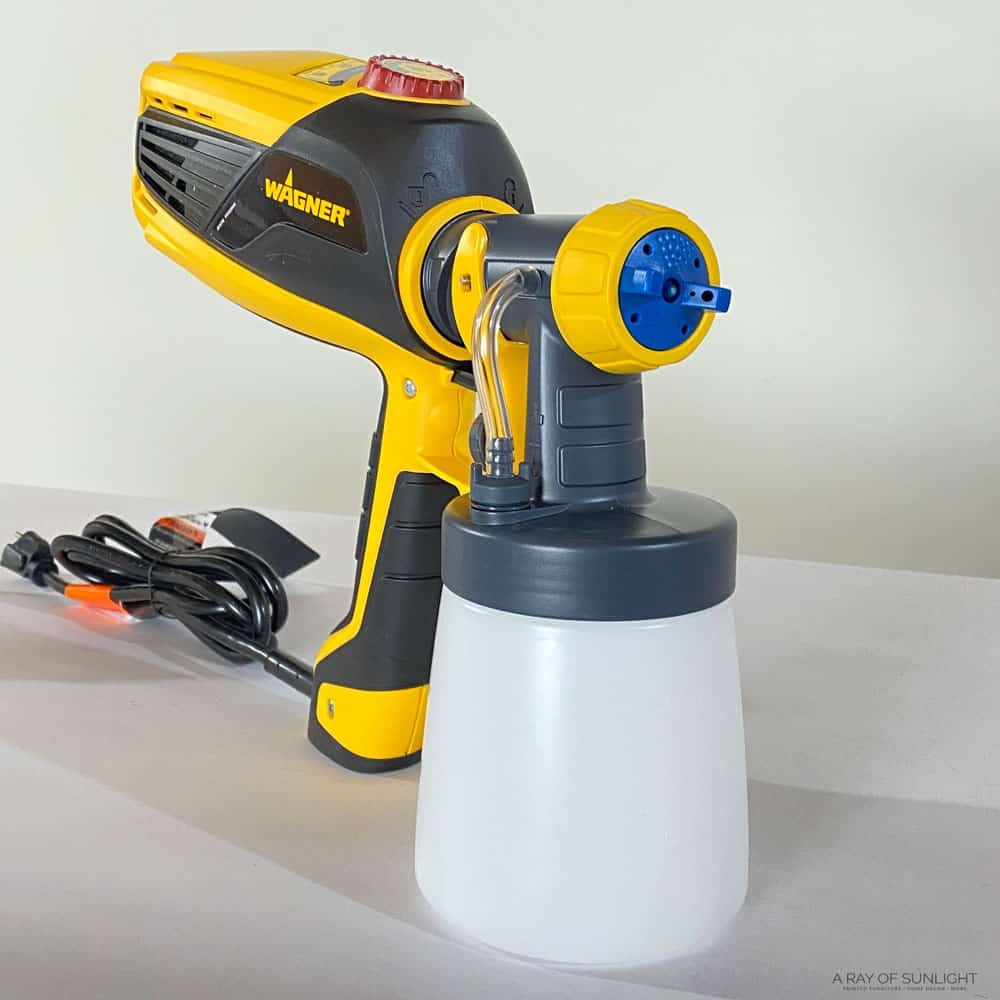
I’ve seen a few other furniture painters use this sprayer, so I really have wanted to test it out and see how it works and how it compares to my other sprayers.
P.S. Check out the comparable HomeRight Super Finish Max paint sprayer here.
And see how it compares to other Wagner paint sprayers in this post on the best Wagner paint sprayers for furniture.
Mixing Chalk Paint
I mixed up a 1 to 1 ratio of two of my favorite colors for this project. This deep blue called Peacoat, and this stunning emerald green called Fireworks.
Check out more Dark Blue Painted Furniture ideas for your next project here.
I poured it into a measuring cup so I could more easily figure out the water to paint ratio that I needed to thin out the paint. And then I mixed the two colors together really well.
Then it was time to thin the paint.
Thinning Chalk Paint for the Paint Sprayer
I was a little bit nervous about this part because this was my first time thinning chalk paint for this paint sprayer (obviously), but I started out by thinning it out by 10% because that’s the measurement I hear about a lot.
I had 2 cups of paint measured out. So I grabbed my calculator and figured out that 2 cups times 10% was .2 of a cup, which is pretty close to a ¼ of a cup.
So I put a little less than a quarter of a cup of water into the paint.
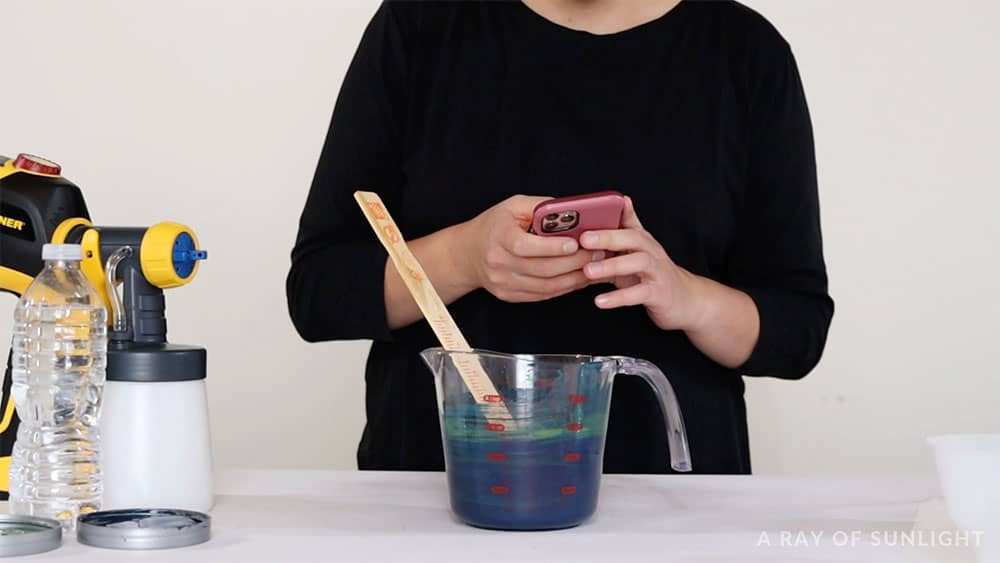
And then I mixed it up really well. But, from my experience of spraying from my other Wagner paint sprayer, the Wagner Double Duty paint sprayer, I felt like it was still a little bit too thick.
I had read on Wagner’s website somewhere in a Q&A that really thick paints might need to be thinned out by 20% instead of just 10%.
And this Country Chic paint is some pretty thick paint! I also know that it can handle being thinned out a lot more than some other types of paint can.
Check out my honest and detailed Country Chic Paint Review here.
So I decided to add another almost quarter cup of water to the mix to thin it out by a total of 20%.

After the water was completely mixed into the paint, I thought that the paint consistency looked a lot like it has when I’ve used the viscosity cup that was included with my other Wagner paint sprayer.
So I decided to give it a try. I poured it in the sprayer, using a mesh filter to make sure that there weren’t any clumps or debris in the paint that could clog the paint sprayer.
Learn more about how to thin paint for Wagner FLEXiO sprayer here.
Testing the Paint Sprayer
Included with the sprayer was a poster that you can spray on to test out the sprayer and to practice getting used to it. So I taped it to my wall and tested it out!
I set the power setting on the top to 5, made sure the spray pattern was set to spray horizontally and twisted the material flow knob so less paint came out. And then I plugged in the sprayer.
I pointed the sprayer at the poster and pulled the trigger back just a little bit to get the turbine going. Then I pulled it all the way back and sprayed it across the poster.
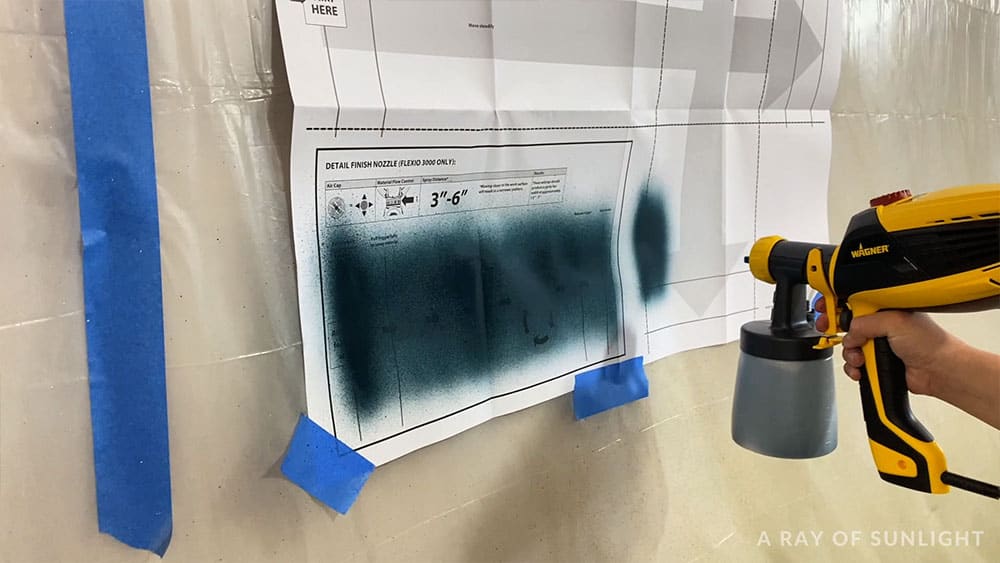
I adjusted the material flow and power settings a few times. I was pretty happy with the thickness of the paint and how it was spraying a really fine mist, so I moved on to spraying the nightstands.
Chalk Painting the Nightstands with a Sprayer
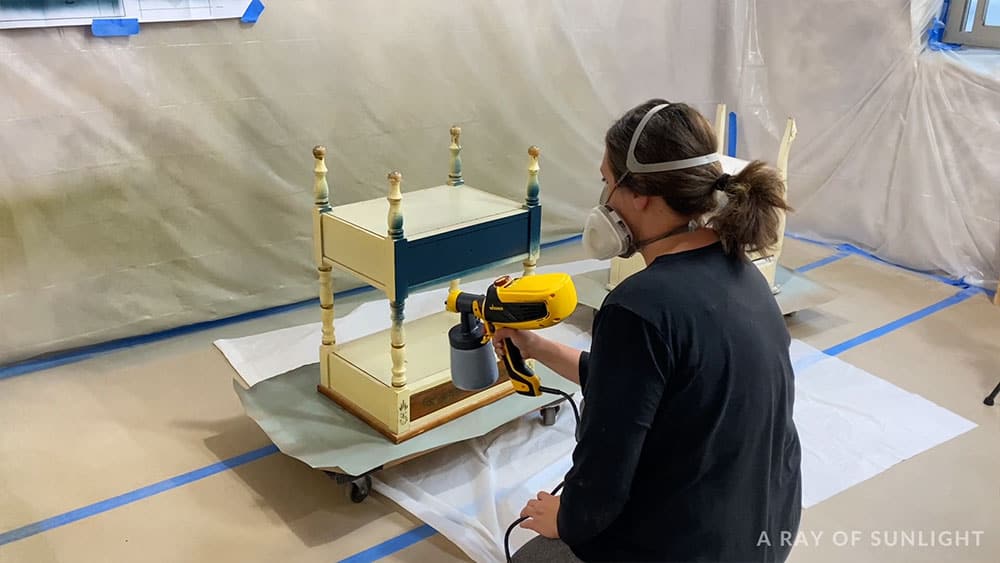
After the first pass though, I realized that it was coming out way too much for my comfort. So I messed around with the settings some more…
And then I realized that I was turning the material flow knob the wrong direction! Haha Ooops!
So I unscrewed it a lot, and then I slowly screwed it back in a little bit at a time, testing it after a few twists to see if the paint was coming out enough.
After a few more twists I got it to the setting that I liked and felt comfortable with. Somewhere in the middle… not too much, and not too little.
If too much is coming out, then you get more overspray in the air which wastes paint.
But too much paint also can cause the paint to drip, sag or puddle on the furniture, and then you have to fix it. So I try to error on the side of less paint coming out.
Here’s what they looked like after one coat of paint.
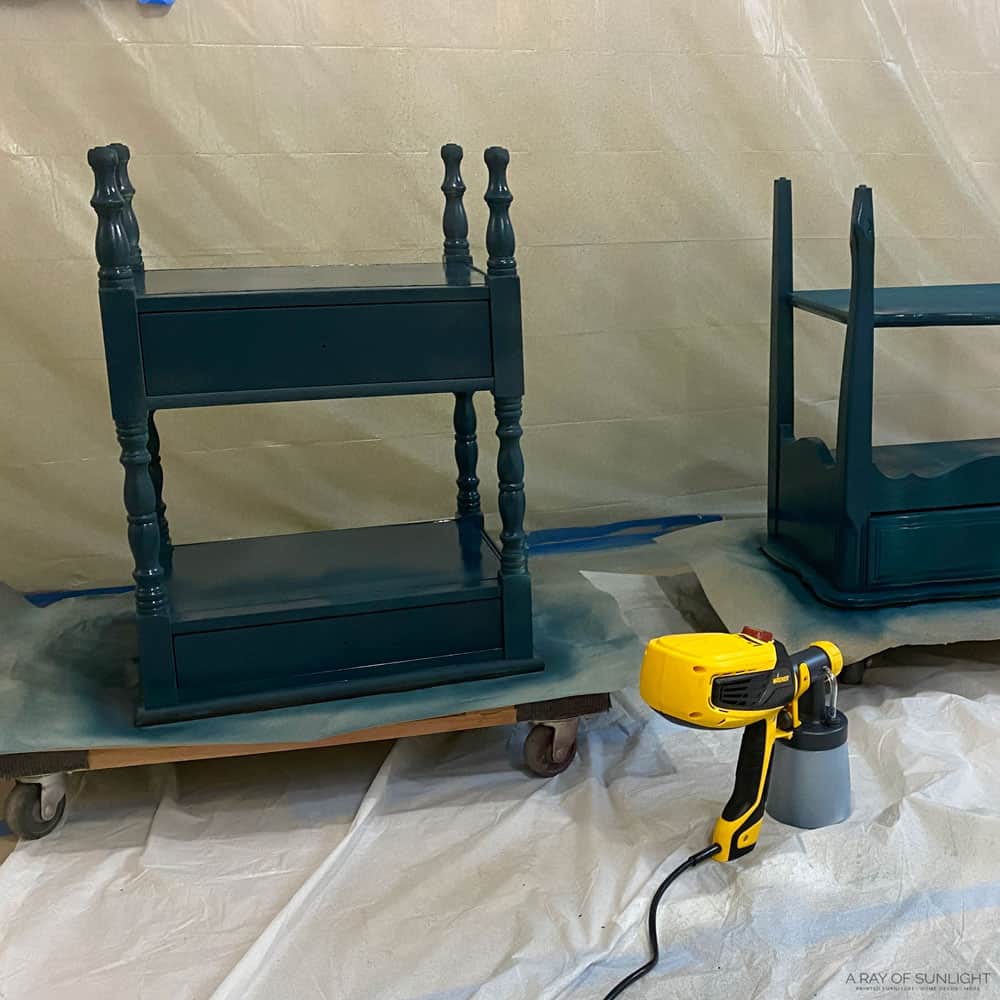
You could still see a little bit of the old finish, but most of it was covered with a thin coat of paint.
So I gave it all a second coat of paint, and let it dry before I flipped them over to give them a coat on the right side.
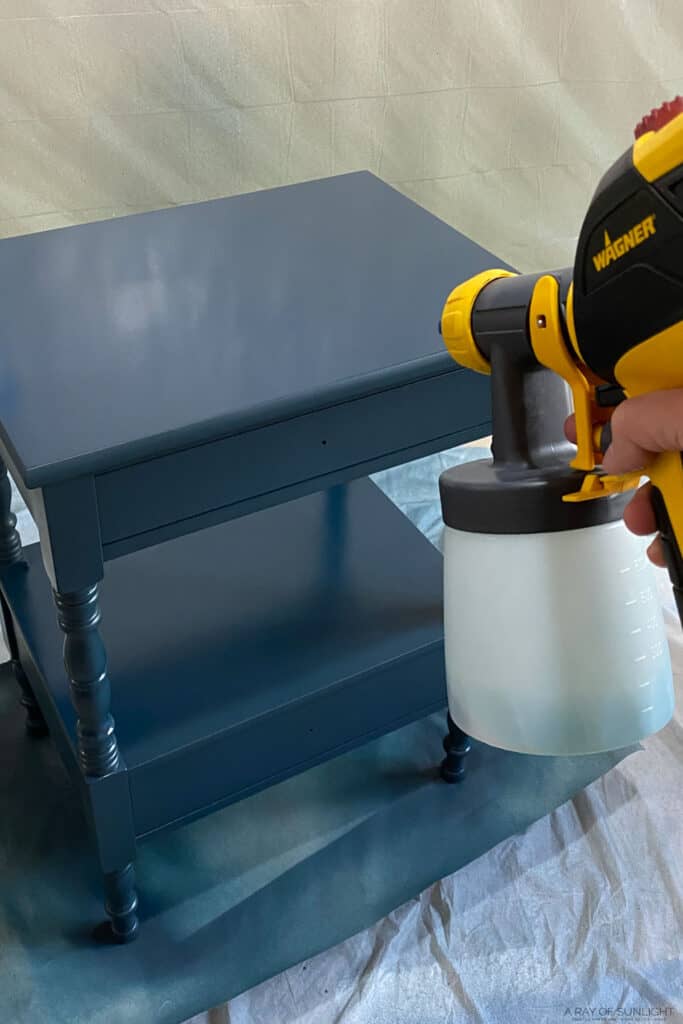
After the first coat was dry on the right side, I could see outlines of the places where the old paint had chipped in the details on the top.
So I grabbed some 220 grit sandpaper and smoothed those areas out better than I had before. Sometimes you just don’t see the imperfections until you get some paint on.
Then I cleaned up all the dust that I created and sprayed another coat all over.
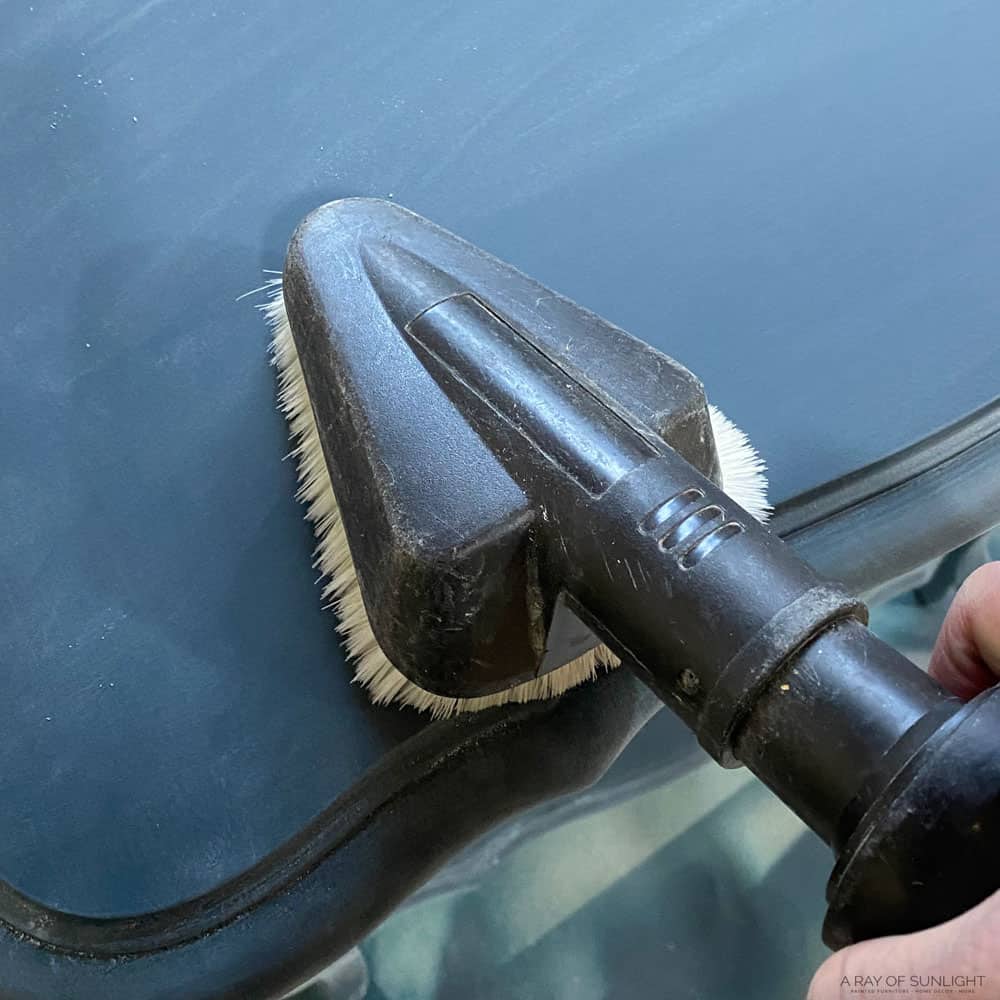
Topcoat Blue Painted Nightstands
And then I cleaned out my paint sprayer (here’s how to clean a Wagner paint sprayer) and started mixing up the poly for my topcoat. Learn more about the best topcoats for painting furniture here!

How To Spray Polyurethane
First, I stirred and stirred and stirred the poly. And then I stirred it some more. Then I added some water to thin out the poly a little and help it look better when it sprays.
I also added a little bit of my paint into the poly. And mixed it together really well. This is a trick that I was reminded about from Katie Scott at Salvaged by K Scott. (She is a furniture painting genius!)
Read these tutorials about how to spray polyurethane and how to apply polyacrylic to painted furniture to learn more!
So after I stirred up the poly, added some water and paint to it, and stirred it really well again, I was ready to spray it. Once again I sprayed it on the practice poster.
And man am I glad that I did! I would have had a huge drip on my nightstands!
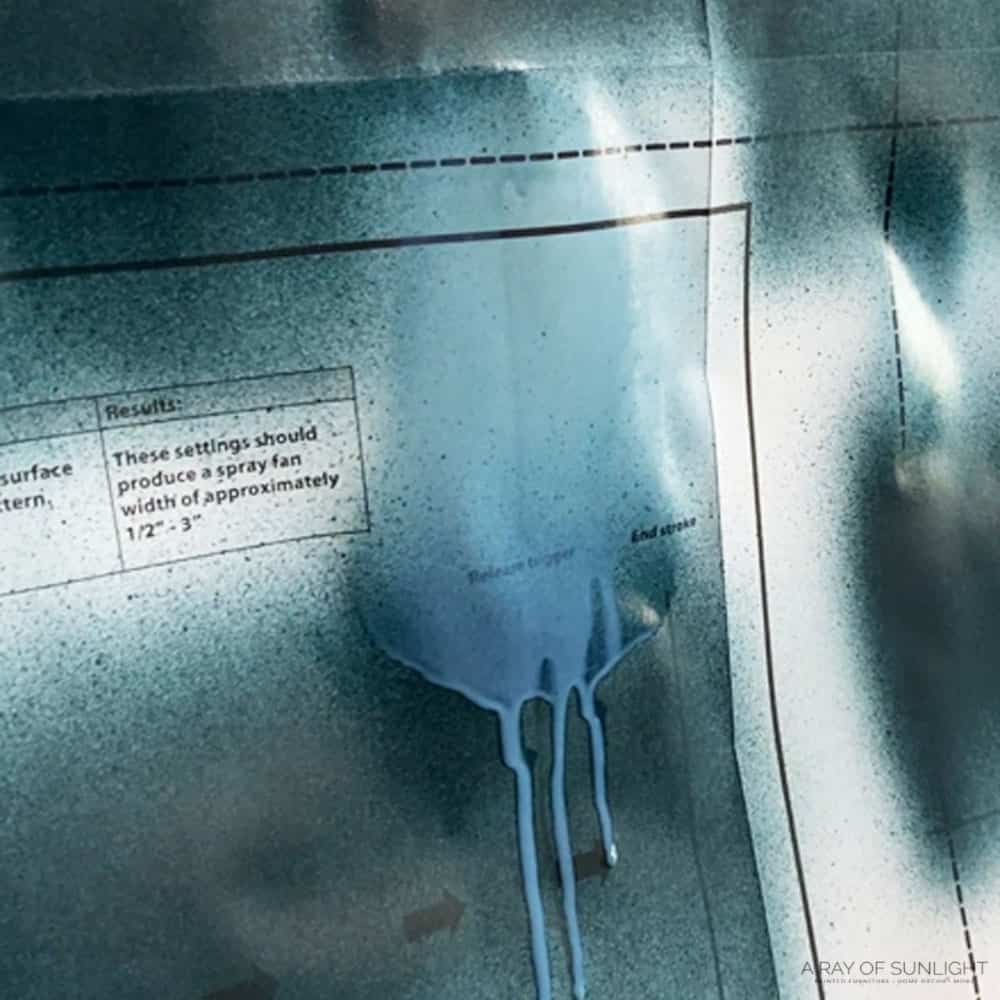
I sprayed the first coat of poly and let it dry completely for about an hour. Learn about the difference between spray polyurethane vs brush on polyurethane here.
Then I grabbed a very fine SurfPrep foam pad and sanded everything down. This was just to smooth the finish out so it felt really nice and soft.
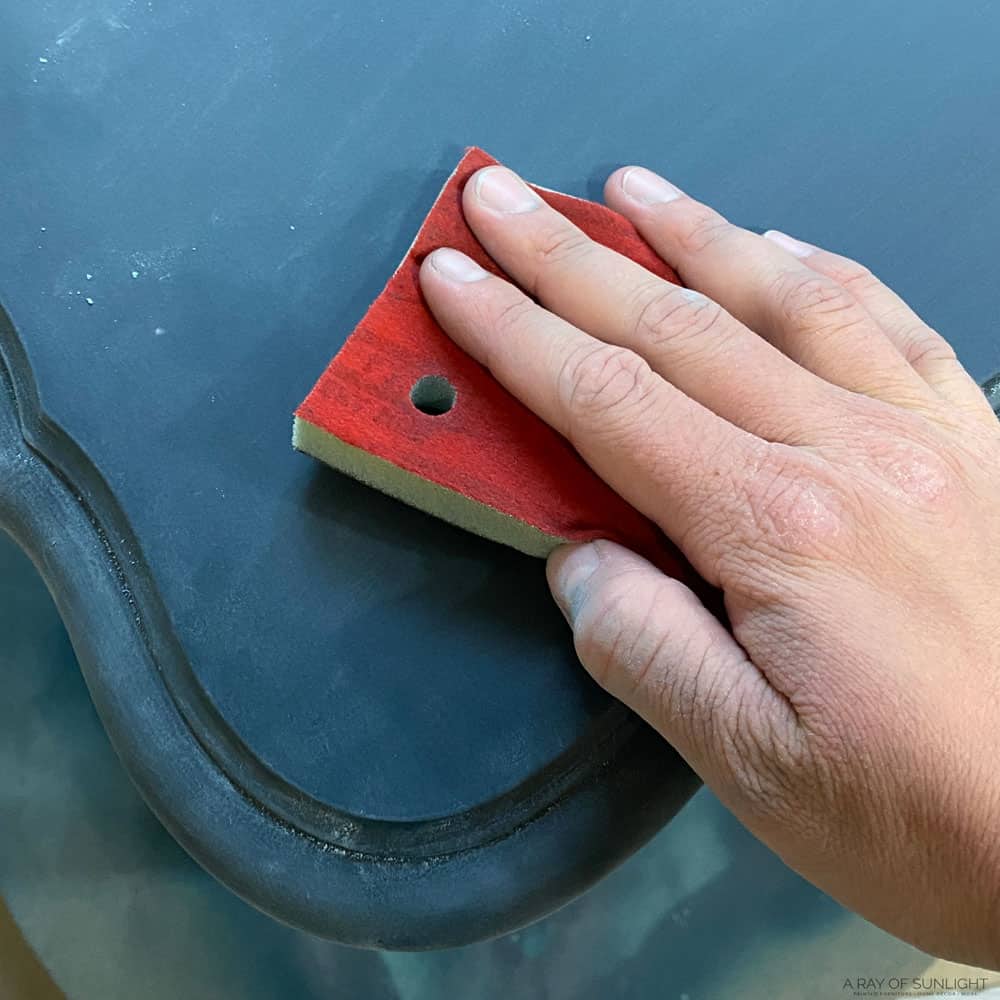

Then I cleaned all the dust off with my shop vac and tack cloth. And then I sprayed on 3 more coats of poly, including one where the nightstands were upside down again.
Add New Hardware to Blue Nightstands
The next day I drilled a new hole for a knob, and added these new knobs onto the nightstands.
Here’s what they look like now!
Check out more French Painted Furniture ideas here.


More Before And After Makeovers
Click any of these “before” photos below to view the “after” of that makeover.

More About Thinning Paint
Let’s talk for a second about thinning the paint.
Yep, the Detail Finish Nozzle does require that the paint be thinned out a bit, especially if you’re using chalk paint. Honestly though, that’s not surprising to me one little bit.
I have a professional grade expensive paint sprayer (read my honest review and thoughts on the Fuji Q4 paint sprayer here), and I still thin my paint with that bad boy. (Though I don’t measure it at all!) Even though it can spray thick chalk paint just fine.
Thinning out the paint gives it the ability to atomize and create a really nice fine finish. Basically, a finish that doesn’t have a bunch of texture or splatters in it.
So even if this paint sprayer didn’t require the paint to be thinned with the Detail Finish Nozzle, I still would thin the paint at least a small amount.
This paint sprayer doesn’t come with a viscosity cup like my other Wagner paint sprayer does, so I was a little bit worried about getting the paint just right for this sprayer.
It ended up being really easy though to measure how much paint I was putting in the sprayer and then multiplying that by 10 or 20 percent to see how much water I needed to add.
More Mismatched Nightstand Makeovers
- Repurpose Sewing Machine Tables
- DIY Emerald Green Mismatched Nightstands
- Grey Painted Dressers
- French Blue Dressers
Follow us on YouTube to get more tips for painting furniture.
Or share your project with us on our Facebook Group and be part of our community. See you there!


